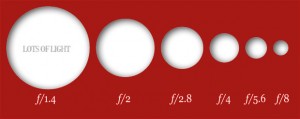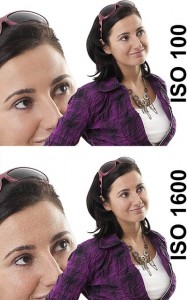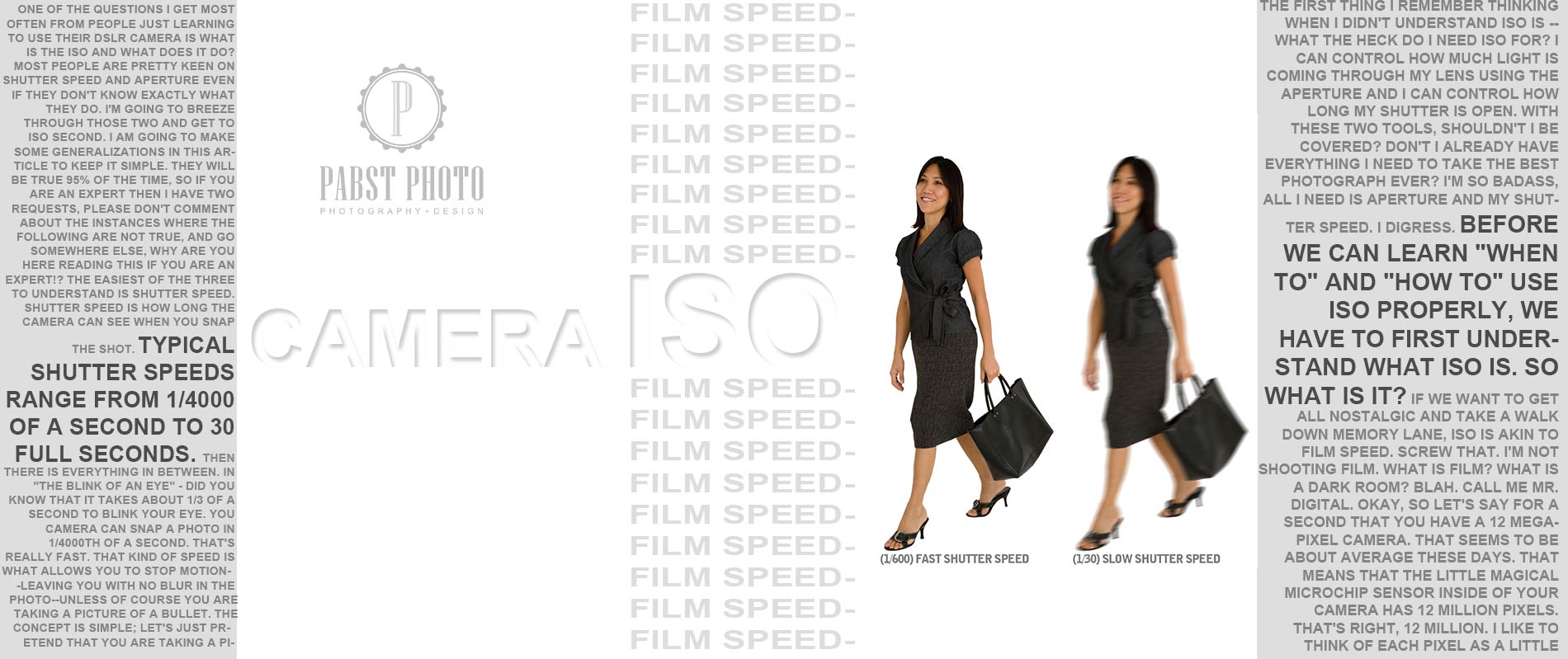Camera ISO, What is it?
One of the questions I get most often from people just learning to use their DSLR camera is what is Camera ISO and what does it do? Most people are pretty keen on shutter speed and aperture even if they don’t know exactly what they do. I’m going to breeze through those two and get to ISO second. I am going to make some generalizations in this article to keep it simple. They will be true 95% of the time, so if you are an expert then I have two requests, please don’t comment about the instances where the following are not true, and go somewhere else, why are you here reading this if you are an expert!?
Fast Shutter Speed = Freezing the Action | Slow Shutter Speed = More light, but more chance for Blur
 The easiest of the three to understand is shutter speed. Shutter speed is how long the camera can see when you snap the shot. Typical shutter speeds range from 1/4000 of a second to 30 full seconds. Then there is everything in between. In “The Blink of an Eye” – did you know that it takes about 1/3 of a second to blink your eye. You camera can snap a photo in 1/4000th of a second. That’s really fast. That kind of speed is what allows you to stop motion–leaving you with no blur in the photo–unless of course you are taking a picture of a bullet. The concept is simple; let’s just pretend that you are taking a picture of a kid playing soccer. If your shutter speed is 1/4000 of a second then he will be frozen and not blurry, unless he’s faster than Carl Lewis. If your shutter speed of the same kid playing soccer is 1 second, then your photo will be blurry. You know, kids can move a lot in a full second. Even in a 1/3 of a second, remember the time it takes to blink, if that kid is running, and you blink, when you open your eye, he will have moved quite a bit–even though blinking seems fast, it’s not. In my example I used this lady carrying a bag. She’s not even running.
The easiest of the three to understand is shutter speed. Shutter speed is how long the camera can see when you snap the shot. Typical shutter speeds range from 1/4000 of a second to 30 full seconds. Then there is everything in between. In “The Blink of an Eye” – did you know that it takes about 1/3 of a second to blink your eye. You camera can snap a photo in 1/4000th of a second. That’s really fast. That kind of speed is what allows you to stop motion–leaving you with no blur in the photo–unless of course you are taking a picture of a bullet. The concept is simple; let’s just pretend that you are taking a picture of a kid playing soccer. If your shutter speed is 1/4000 of a second then he will be frozen and not blurry, unless he’s faster than Carl Lewis. If your shutter speed of the same kid playing soccer is 1 second, then your photo will be blurry. You know, kids can move a lot in a full second. Even in a 1/3 of a second, remember the time it takes to blink, if that kid is running, and you blink, when you open your eye, he will have moved quite a bit–even though blinking seems fast, it’s not. In my example I used this lady carrying a bag. She’s not even running.
Big Hole = More Light

The moving part in your camera (lens) is the aperture. It’s basically changing the size of the hole in your camera lens. Here’s the shocker–the bigger the hole (f/1.8), the more light that gets in. Wow, I know, a real mind bender. And, you guessed it, the smaller the hole (f/22), the less light that gets in. So, wait a second, you mean to tell me that the smaller the number the bigger the hole? Yes. Sorry, but yeah, that’s how the geniuses worked it out. I don’t have a clever way of remembering. Just remember that 1, is pretty much 100% open. Big hole = more light. That’s always better right? Well, kind of. Nothing is that simple. Bigger hole means a more shallow depth of field, so less of your image is in focus. Unless you want a really soft and blurry background, in which case, big hole is definitely good. Big Hole = blurry background. Here is an in depth look at camera aperture settings.
Camera ISO | What’s The Point?
The first thing I remember thinking when I didn’t understand ISO is — what the heck do I need ISO for? I can control how much light is coming through my lens using the aperture and I can control how long my shutter is open. With these two tools, shouldn’t I be covered? Don’t I already have everything I need to take the best photograph ever? I’m so badass, all I need is aperture and my shutter speed. I digress. Before we can learn “when to” and “how to” use ISO properly, we have to first understand what ISO is. So what is it? If we want to get all nostalgic and take a walk down memory lane, ISO is akin to Film Speed. Screw that. I’m not shooting film. What is film? What is a dark room? Blah. Call me Mr. Digital. Okay, so let’s say for a second that you have a 12 megapixel camera. That seems to be about average these days. That means that the little magical microchip sensor inside of your camera has 12 million pixels. That’s right, 12 million. I like to think of each pixel as a little creature. Inside your 12 megapixel camera there are 12 million little creatures who love light. They love it; can’t get enough of it. They are the opposite of vampires. They hate the dark. The dark makes all 12,000,000 creatures (pixels) angry. Okay Josh, you’re not helping. All right, so, ISO typically ranges from about 100 to 12800. Again, kind of like aperture, low numbers are good! ISO 100 is good. ISO 12800 is bad. Here’s why.
Scenario Number 1
Let’s say on a bright sunny day outside, your best friend is sitting on a park bench and you set your camera to ISO 100. You set your aperture to f/5 and your shutter speed to 1/320 sec. You aim, focus, and take the picture. Your camera is only open for 1/320th of a second, but in that short amount of time lots of glorious light from the bright sun comes in and each of the 12,000,000 creatures are happy. They breathed in the light for 1/320th of a second and converted that light into ones and zeros that your camera turned into a colored pixel. No big deal. All the creatures are happy, they all got plenty of light. Hooray!
Scenario Number 2
You are sitting in your living room at 8pm and a child is playing on the floor. Let’s assume that you don’t live in the worlds most incredible house with hundreds of lights on the ceiling. No, you live in a normal house with normal lights and hopefully a normal kid who is playing on the floor. To you and the kid, it looks pretty light in the room. You can see what you are doing. You can read the book in your hand and see the color of the wine you are drinking in the other. BUT, it’s definitely darker than scenario one. You put your book and glass of wine down and grab your camera. It’s still in manual mode from when you were photographing your friend on the bench this afternoon. You change nothing, aim at your child and snap the photo. Shoot. My child is a ghost. Not even there. Did I leave the lens cap on? Why is this image all black. Oh, no worry, I know what to do. I was shooting at the park using f/4.0, I will just change it to f/2.8. You leave the camera at ISO 100 and the shutter at 1/320 and snap the picture. Shoot. Maybe my child is a ghost. No, I know what to do. You can’t make the hole any bigger because f/2.8 is the maximum aperture on your lens. Have no fear. you change your shutter speed to 1/60th of a second. You aim, take the picture. Now you are seriously worried that your child is a ghost. You breathe deep, and adjust the shutter speed to 2 seconds. Relief sets in, you can see your child, but he actually looks like a ghost now. He’s blurry beyond recognition because your hands moved the camera and your kid moved like three feet in those 2 seconds. You are out of options. Wait, ISO to the rescue.
ISO To The Rescue
Your child is not sitting still. So, you use your massive brain and realize that you are going to need to keep the shutter speed around 1/80 of a second because that will be just fast enough to keep it from being blurry, but also long enough to let in a good amount of light. Got it. That’s locked. Moving on. You use that massive brain of yours again and lock in the largest aperture on your lens because you know that the bigger the hole the more light can get in. Now, you are ready to adjust your ISO. You crank up your ISO to 200, then 400, then 800, then 1600. Finally, at 1600 ISO your shot looks great on that 2 inch LCD on the back of your camera. Tears of joy are running down your face. All that money you spent on that fancy camera! And it works! Why didn’t you buy the one with the flash? Oh, you did? You used the flash and the pictures look horrible, no surprise, that’s why you are reading about ISO. You think to yourself, only briefly, what’s the big deal, ISO is awesome. I love HIGH ISO. It’s like magic. Then you think, briefly, Josh, why don’t I just use HIGH ISO like all the time, it’s so magical.
You stop, and get up, and head for the Computer.
 You take your newly captured photograph to the computer leaving your child playing on the floor hoping he doesn’t eat another Lego. You open the image on your 20 inch monitor and the image looks pretty darn good. You can’t help but compare it to the one you took this afternoon of your friend on a park bench. You look closer and notice that the image you took of your kid is just not as sharp and it has a bunch of grain. Worry sets in again. Your heart races. What’s happening? You zoom way in on the image and notice all the grain. The pixels are not perfect like the photo from this afternoon. Remember all those 12,000,000 light-loving creatures inside of your camera, well in your normal house, they didn’t get that much light. The sun was not out. And even though you opened your lens to f/2.8, that 1/80th of a second just wasn’t long enough for all those creatures to get all the delicious light they so desired. So, they started a riot. Those creatures, each responsible for capturing one pixel of your image started fighting for that light coming in. They started jumping on and over each other. That’s where all that grain came from. Stupid creatures.
You take your newly captured photograph to the computer leaving your child playing on the floor hoping he doesn’t eat another Lego. You open the image on your 20 inch monitor and the image looks pretty darn good. You can’t help but compare it to the one you took this afternoon of your friend on a park bench. You look closer and notice that the image you took of your kid is just not as sharp and it has a bunch of grain. Worry sets in again. Your heart races. What’s happening? You zoom way in on the image and notice all the grain. The pixels are not perfect like the photo from this afternoon. Remember all those 12,000,000 light-loving creatures inside of your camera, well in your normal house, they didn’t get that much light. The sun was not out. And even though you opened your lens to f/2.8, that 1/80th of a second just wasn’t long enough for all those creatures to get all the delicious light they so desired. So, they started a riot. Those creatures, each responsible for capturing one pixel of your image started fighting for that light coming in. They started jumping on and over each other. That’s where all that grain came from. Stupid creatures.
Conclusion : High ISO = Brighter Image, but More Noise
This post is anything but technical, so I’d like to keep it that way. You can really think about those 12,000,000 creatures. On a big sensor (sensor size) each creature is bigger. A 12 megapixel camera with a sensor the size of a stamp is going to outperform a 12 megapixel camera with a sensor the size of pinky-toe-nail. That’s because each creature on the big sensor is also bigger. So they are stronger. They fight for light more efficiently. So don’t think that more megapixels is better because it often is not–it’s a sales gimmick and most of the public has been duped.
Just remember, that HIGH ISO will make your photos brighter, but it will also make them less sharp and more grainy. If you can, you should try to keep your ISO at 400 and below, though this is changing as sensor technology gets better and better. Many cameras perform amazingly even at ISO 1600 today. It will be up to you to decide which looks better; the picture with the flash turned on at ISO 100 or the picture with the flash turned off at ISO 32000. For Flash Photography tips.
Thanks for visiting Pabst Photo. If you enjoyed this article, please share it with the world using the social icons or whatever. Sharing is caring. Leave a comment. Happy Shooting. Want more, check out other Photography Tips.

FABULOUS!! I got so many chuckles from reading this & I actually think, for the first time in years, I am starting to get this! Thank you for taking the time to explain this using understandable & fun examples!
Hey, this whole thing about ISO is just awesome. Its like i was reading a very very cute novel.
Thanks for explaining it very beautifuly.
But i have few questions to ask.
In scenario number 2 the light’s source is fixed ( i mean, no other source of light is added), then how increase in the ISO make picture bright?
From where that extra light came? What it exactly means to increase the sensitivity of film?
I hope my question’s are quite relevant or understandable.
Vikram; ISO the 3rd way your camera can make an image brighter. Perhaps you should re-read the article. Take your time.